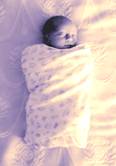
TUESDAY, Nov. 22 (HealthDay News) — A comfortable and safe sleep environment is crucial for infants and could mean the different between life and death, pediatricians say.
Sudden infant death syndrome remains the leading cause of death for children younger than one year, according to the U.S. Centers for Disease Control and Prevention. There’s been a significant decline in the number of SIDS-related deaths since the American Academy of Pediatrics recommended that all babies be placed on their backs.
But sleep-related deaths caused by entrapment, suffocation and asphyxia have increased, leading the AAP to expand its sleep safety guidelines.
“These new guidelines will help enlighten parents about what items and behaviors can lead to infant sleep-related deaths,” Dr. Lisa Martin, a pediatrician at Loyola University Health System and an associate professor of pediatrics at Loyola University Chicago Stritch School of Medicine, said in a Loyola news release.
“Infants, especially young infants, are completely dependent on their caregivers to provide a safe sleep environment, since they don’t have the ability to roll away from objects that are restricting their breathing,” she noted.
As well as always placing infants on their backs to sleep, the AAP says babies should be placed on a firm sleep surface and the crib should be free of objects such as loose bedding, bumper pads, pillows and stuffed animals.
“There are numerous products out there that are not necessary and could even become death traps for a baby. Items like bumper pads and sleep positioners have not been shown to prevent injuries, and the concern is that an infant can get trapped and suffocate,” Martin said.
“Babies don’t care if they have a boring crib; they do care if it’s safe. The more objects in a sleeping space, the more dangerous it is for a baby,” she added.
A good rule of thumb for keeping babies warm is to dress them in one additional layer of clothing above what a parent is wearing, Martin advised. For example, if a parent is wearing two layers, a baby will need three.
Another AAP recommendation is to offer infants a pacifier at nap and bedtime.
“Pacifiers have been shown to protect against SIDS, but if a mother is planning on breast-feeding, wait to offer it until the baby is three or four weeks old and make sure breast-feeding habits have been established,” Martin said.
More information
Here’s where you can find the complete list of AAP recommendations for reducing the risk of SIDS.

